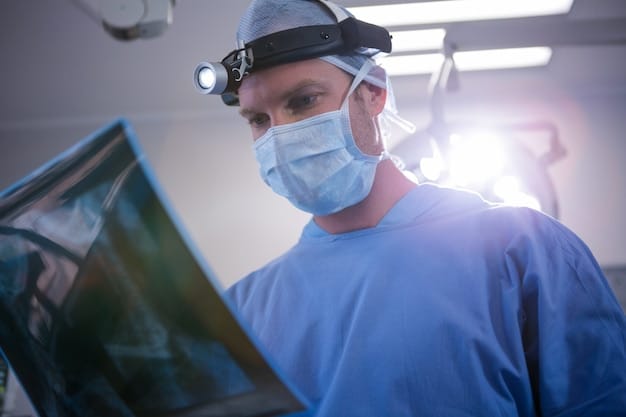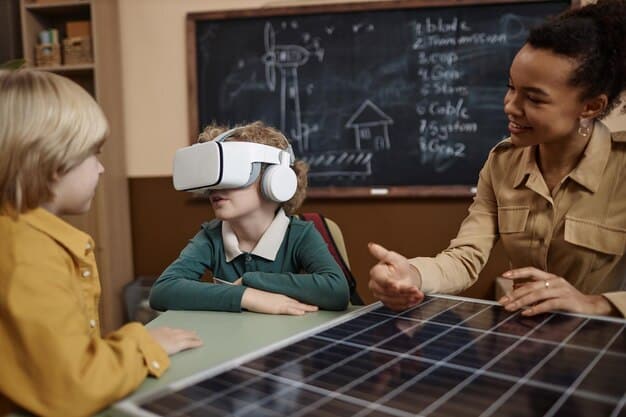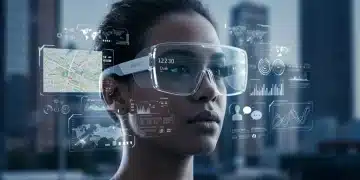Exploring Augmented Reality Glasses: Real-World Uses Beyond Gaming

Augmented Reality (AR) glasses are evolving beyond gaming, offering innovative solutions in fields like healthcare, education, manufacturing, and retail by overlaying digital information onto the real world.
Augmented Reality (AR) glasses: What Are the Real-World Applications Beyond Gaming? While often associated with immersive gaming experiences, AR glasses are rapidly expanding their horizons, impacting various industries and daily life in surprising ways.
Beyond the Screen: Augmented Reality Glasses Applications
Augmented reality (AR) glasses are stepping out of the gaming world and into our daily lives. These glasses overlay digital information onto what we see, offering a new way to interact with our surroundings. From helping doctors perform surgery to guiding technicians through complex repairs, AR glasses are finding practical applications across many sectors.
Let’s explore the various ways AR glasses are being used to improve efficiency, enhance learning, and provide innovative solutions in industries beyond entertainment.

Healthcare Revolutionized: AR Glasses in Medicine
The healthcare sector is witnessing a significant transformation with the introduction of AR glasses. These devices offer medical professionals real-time access to crucial information, improving diagnostic accuracy and enhancing patient care. The ability to overlay digital data onto the physical world is proving invaluable in various medical fields.
Surgical Precision and Training
AR glasses are being used to enhance surgical precision by providing surgeons with real-time access to patient scans and vital data during procedures. This eliminates the need to look away at monitors, allowing for continuous focus on the surgical field. For training purposes, AR glasses offer a hands-on learning experience, allowing medical students to practice complex procedures in a safe and controlled environment.
Remote Assistance and Telemedicine
AR glasses facilitate remote assistance, enabling experienced specialists to guide on-site medical staff through complex procedures. This is particularly useful in remote or underserved areas where access to specialized knowledge is limited. Furthermore, AR glasses are enhancing telemedicine by allowing doctors to examine patients remotely, providing virtual consultations and monitoring vital signs in real-time.
- Enhanced Diagnostics: Real-time access to patient data for quicker and more accurate diagnoses.
- Improved Training: Hands-on learning experiences for medical students.
- Remote Support: Enables experts to guide on-site personnel from afar.
- Telemedicine Advancement: Facilitates remote patient exams and consultations.
AR glasses are transforming healthcare by improving precision, enhancing training, facilitating remote assistance, and advancing telemedicine, ultimately leading to better patient outcomes and more efficient healthcare delivery.
Education Reimagined: AR Glasses in Learning
AR glasses are transforming education by providing students with immersive and interactive learning experiences. By overlaying digital content onto the real world, these glasses make learning more engaging, accessible, and effective. The ability to visualize complex concepts and interact with educational content in a tangible way is revolutionizing the classroom.
Let’s explore the various ways AR glasses are being used to enhance education and improve student outcomes.
Interactive Lessons and 3D Visualizations
AR glasses bring lessons to life by allowing students to interact with 3D models and simulations. Subjects like history, science, and geography become more engaging when students can virtually explore ancient civilizations, dissect a virtual frog, or tour the world from their desks. This interactive approach enhances understanding and retention, making learning more effective.
Personalized Learning Experiences
AR glasses can adapt to individual learning styles and paces, providing personalized educational content tailored to each student’s needs. The glasses can track student progress and adjust the difficulty of lessons accordingly, ensuring that each student receives the appropriate level of challenge and support. This personalized approach maximizes learning outcomes and fosters a love for learning.

- Engaging Content: Interactive lessons and 3D visualizations that bring subjects to life.
- Personalized Education: Tailored content that adapts to individual learning styles.
- Accessible Learning: Provides learning opportunities for students with disabilities.
- Real-World Application: Connects classroom learning to real-world scenarios.
AR glasses are revolutionizing education by providing engaging, personalized, and accessible learning experiences, ultimately leading to improved student outcomes and a deeper understanding of the world.
Manufacturing and Industry: Enhancing Productivity
In the manufacturing and industrial sectors, AR glasses are proving invaluable for enhancing productivity and streamlining operations. By providing workers with real-time information and guidance, these glasses improve efficiency, reduce errors, and enhance safety. The ability to overlay digital instructions onto the physical workspace is transforming how tasks are performed.
Let’s delve into the various ways AR glasses are being used to optimize manufacturing processes and improve worker performance.
Guided Assembly and Maintenance
AR glasses guide workers through complex assembly and maintenance tasks by overlaying step-by-step instructions onto the equipment they are working on. This reduces the need for paper manuals or constant consultation with supervisors, allowing workers to complete tasks faster and with greater accuracy. The glasses also provide visual cues and alerts, minimizing the risk of errors and ensuring consistent quality.
Remote Expert Support
AR glasses facilitate remote expert support, allowing experienced technicians to guide on-site workers through troubleshooting and repair procedures. This reduces downtime and minimizes the need for costly on-site visits from specialists. The remote expert can see what the on-site worker sees, providing real-time guidance and instructions to resolve issues quickly and efficiently.
- Efficient Assembly: Step-by-step instructions for faster and more accurate assembly.
- Optimized Maintenance: Real-time guidance for troubleshooting and repairs.
- Remote Collaboration: Enables remote experts to assist on-site workers.
- Enhanced Safety: Visual cues and alerts to minimize risks and accidents.
AR glasses are revolutionizing manufacturing and industry by enhancing productivity, improving accuracy, facilitating remote support, and enhancing safety, ultimately leading to more efficient operations and reduced costs.
Retail and Customer Experience: A New Dimension
AR glasses are transforming the retail sector by providing customers with immersive and personalized shopping experiences. By overlaying digital content onto products and displays, these glasses enhance customer engagement, provide valuable information, and drive sales. The ability to virtually “try on” products or visualize furniture in their homes is revolutionizing the way people shop.
Let’s explore the various ways AR glasses are being used to enhance the retail experience and improve customer satisfaction.
Virtual Try-Ons and Product Visualization
AR glasses allow customers to virtually try on clothing, accessories, and makeup without physically touching the products. This is particularly useful for online shopping, where customers can see how a product looks on them before making a purchase. Similarly, AR glasses enable customers to visualize furniture and décor in their homes, helping them make informed purchasing decisions and reducing the likelihood of returns.
In-Store Navigation and Product Information
AR glasses provide in-store navigation, guiding customers to specific products and displays. The glasses also overlay product information, such as price, features, and reviews, onto the products themselves. This enhances the shopping experience by providing customers with all the information they need to make informed decisions, without having to search for it themselves.
- Enhanced Engagement: Immersive shopping experiences that capture customer attention.
- Personalized Shopping: Virtual try-ons and product visualizations tailored to individual preferences.
- Informed Decisions: Real-time access to product information and reviews.
- Improved Satisfaction: Convenient navigation and streamlined purchasing process.
AR glasses are enhancing the retail and customer experience by providing engaging, personalized, and informative shopping experiences, ultimately leading to increased customer satisfaction and sales.
Logistics and Supply Chain: Optimizing Operations
The logistics and supply chain industry is experiencing a significant boost from the integration of AR glasses. These devices offer hands-free access to critical information, improving efficiency in warehousing, transportation, and delivery processes. By streamlining operations and reducing errors, AR glasses are optimizing the entire supply chain.
Let’s examine the various ways AR glasses are being utilized to enhance logistics and supply chain management.
Warehouse Management and Order Picking
AR glasses guide warehouse workers through order picking tasks, displaying optimal routes and item locations directly in their field of vision. This reduces the time spent searching for items and minimizes errors, leading to faster and more accurate order fulfillment. The hands-free nature of AR glasses also allows workers to perform tasks more efficiently, as they can keep both hands free for handling items.
Real-Time Tracking and Delivery
AR glasses provide real-time tracking of shipments and deliveries, allowing drivers to monitor the status of their cargo and receive updates on delivery schedules. The glasses also provide navigation assistance, guiding drivers along the most efficient routes and alerting them to potential delays or obstacles. This ensures timely and accurate deliveries, improving customer satisfaction and reducing transportation costs.
- Efficient Warehousing: Optimized order picking and inventory management.
- Improved Tracking: Real-time monitoring of shipments and deliveries.
- Streamlined Logistics: Enhanced navigation and route optimization.
- Reduced Errors: Minimizes errors in order fulfillment and delivery processes.
AR glasses are optimizing logistics and supply chain operations by improving efficiency, enhancing accuracy, and providing real-time visibility, ultimately leading to reduced costs and increased customer satisfaction.
Accessibility and Inclusion: Empowering Individuals
Beyond their applications in various industries, AR glasses are playing a crucial role in promoting accessibility and inclusion for individuals with disabilities. These devices offer innovative solutions that help overcome challenges and enhance the quality of life for people with visual, auditory, and cognitive impairments. By providing customized assistance and support, AR glasses are empowering individuals to lead more independent and fulfilling lives.
Let’s explore the various ways AR glasses are being used to promote accessibility and inclusion.
Visual Assistance for the Visually Impaired
AR glasses provide visual assistance for the visually impaired by enhancing their perception of the environment. The glasses can magnify objects, enhance contrast, and provide text-to-speech capabilities, allowing individuals with low vision to read, navigate, and interact with the world more easily. They can also identify objects and people, providing auditory feedback to help users understand their surroundings.
Hearing Assistance for the Hearing Impaired
AR glasses provide hearing assistance for the hearing impaired by transcribing speech into text and displaying it in the user’s field of vision. This allows individuals with hearing loss to follow conversations and participate more fully in social interactions. The glasses can also provide visual cues for important sounds, such as alarms or doorbells, alerting users to potential hazards or notifications.
- Enhanced Vision: Magnification, contrast enhancement, and text-to-speech for the visually impaired.
- Improved Hearing: Speech-to-text transcription for the hearing impaired.
- Cognitive Support: Reminders, prompts, and navigational assistance for individuals with cognitive impairments.
- Greater Independence: Empowering individuals to lead more independent and fulfilling lives.
AR glasses are promoting accessibility and inclusion by providing customized assistance and support for individuals with disabilities, ultimately empowering them to lead more independent and fulfilling lives.
| Key Areas | Brief Description |
|---|---|
| ⚕️ Healthcare | Enhances surgical precision and enables remote assistance in medical procedures. |
| 🏫 Education | Provides interactive lessons and personalized learning experiences for students. |
| 🏭 Manufacturing | Guides workers through assembly tasks and facilitates remote expert support. |
| 🛒 Retail | Offers virtual try-ons and enhances in-store navigation for customers. |
FAQ
▼
AR glasses provide surgeons with real-time access to patient scans and vital data during procedures, eliminating the need to look away at monitors and enhancing focus on the surgical field.
▼
AR glasses offer interactive lessons and 3D visualizations, making learning more engaging. They also provide personalized educational content tailored to each student’s needs.
▼
AR glasses guide warehouse workers through order picking tasks, displaying optimal routes and item locations directly in their field of vision, reducing time and minimizing errors.
▼
AR glasses enhance perception by magnifying objects, improving contrast, and providing text-to-speech capabilities, aiding in reading and navigation for the visually impaired.
▼
AR glasses allow customers to virtually try on products, visualize furniture in their homes, and access product information, enhancing the overall shopping experience.
Conclusion
From revolutionizing healthcare and education to optimizing manufacturing and logistics, augmented reality glasses: What Are the Real-World Applications Beyond Gaming? applications are vast and transformative. As the technology continues to evolve, we can expect to see even more innovative uses emerge, further blurring the lines between the digital and physical worlds and changing the way we live and work.





